Food lovers enjoy cooking. But how knowledgeable are we when it comes to safe food handling and cooking techniques?
I always put my customers’ health and satisfaction first at every restaurant I work at. I’m grateful for my ServSafe manager certification training and educate my staff on good health safety and proper food handling protocols. My kitchens do multiple health inspections a day in order to maintain and uphold their “A” letter grades. My staff know me as a stickler for finer points and am always pushing them to do better.
But the truth is, I wasn’t always food safety knowledgeable. Back in the early days of my restaurant work, I was what I call “a walking health code violation.”
Small Town Violations
More than twenty years ago I got my start at a fried seafood joint in a small town in Massachusetts. It was the Bon Jovi 80’s and I was a naive, teenage kitchen worker. I microwaved chowders, mixed thousands of milkshakes and frappes on a stainless steel mixer, and grilled the occasional meat patty at a fried seafood shack without ever being educated on any aspect of food safety. The husband and wife team who owned the fried seafood stand, chain-smoked throughout the shift as they cooked and plated leaning towers of fried seafood.
The owners didn’t mind our big 80‘s hair and rock and roll radio we danced to as we worked over the fried clams. They almost certainly didn’t concern themselves with teaching any of their staff how to maintain a spotless kitchen. I washed my hands once a shift and used the same (un-sanitized) rag to clean counters and my equipment for the entire shift. We used sky blue Windex to wipe down the wood counters and stainless cooking equipment. Even when the kitchen reached temperatures above 110 degrees on hot summer days, the thick cream and milk mixture the raw seafood was dipped into was never refrigerated (once we pulled it from the walk-in). I don’t recall ever seeing a thermometer used to check holding temperatures. That’s a culinary memory I’d rather forget.
I discovered much about the food industry back then, but none of what I learned had anything to do with food safety.
Little City Oversights
Later, in the mid 90’s when I began tending bar at a family eatery outside of Boston, I learned very little about safe food handling standards. I was told to taste juices for spoilage and put out vinegar soaked sponges to catch fruit flies, but that was about it. The chef was constantly hung over and he had other things to worry about. The kitchen’s cleanliness reflected his work ethic. We served frozen foods deep-fried in oil that I never saw changed and monster nacho plates that were heated up in a dirty microwave. Vegetarian chili, creamy soups, and sauces were made from scratch and reused until they started to smell bad.
I was food poisoned more than once and frequently got sick.
Upholding an A
It wasn’t until I moved to Los Angeles in the late 90‘s that I was introduced to a more stringent health code with letter grades. Once I started working in LA restaurants and watched my first thorough health inspection, I quickly learned about cross-contamination, internal temperatures for cooked proteins (165º), date labeling, proper cooling techniques, and the danger of ice scoops in ice machines. I became aware of the importance of frequent hand washing, sanitized rags, proper food storage (cold foods must be held at 40º or less), cooling techniques for hot foods, and proper internal temperatures of refrigerators (40 or less).
The more I learned at work, the more clean and safe my home kitchen became. I realized in time how hazardous my own cooking techniques were. I learned to never cut raw meat on the same cutting surface as vegetables. I stopped using the dish sponge to clean the counter top. I began looking at expiration dates on dry and frozen foods. I found that using a thermometer in my oven and to test the internal temperatures of the foods I cooked made an immediate impact on the quality (and safety) of my meals.
Health Inspection for Your Kitchen
Some of the things that health inspectors look for in restaurant kitchens are equally important at home. Among them:
- Do you have a thermometer to check internal temperatures of food? If not, get one!
- Do you have any dried or canned foods on the floor of your kitchen? Foods should never be on floor level and should be at least six inches off the floor.
- Do you have any dented cans or expired food items? If so, toss them!
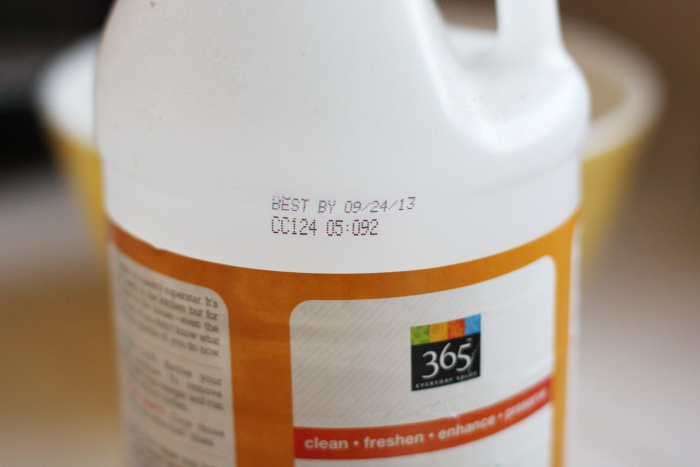
- Look in your refrigerator. Do you have any raw proteins (fish, chicken, beef) anywhere near fruits or vegetables? Make sure to organize your refrigerator with a top to bottom approach. Never put raw meats above uncooked fruits or vegetables. Raw meat should be placed on the bottom shelf, cooked proteins above, and vegetables and fruits in safe distance from the meat.
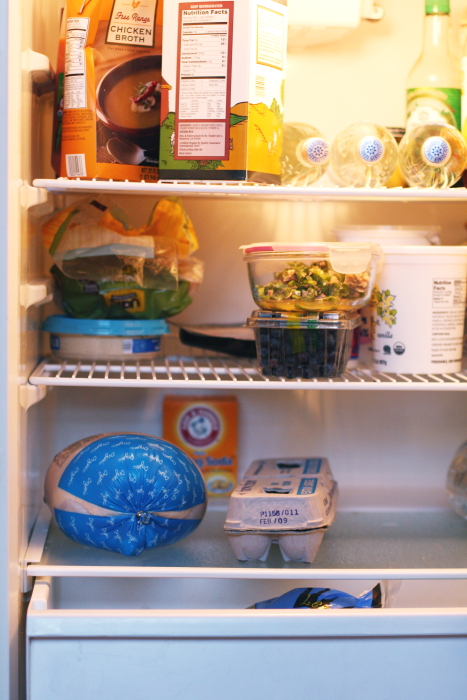 If you are hand washing dishes, it is better to let everything air dry then to use a cloth towel. If you must dry your hand-washed dishes, use a towel that isn’t used to clean counter tops or dry hands.
If you are hand washing dishes, it is better to let everything air dry then to use a cloth towel. If you must dry your hand-washed dishes, use a towel that isn’t used to clean counter tops or dry hands.
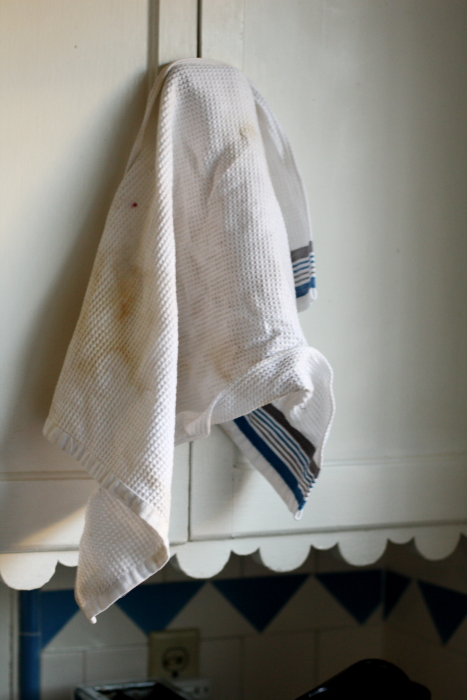 Make sure to use different cutting boards for raw meats, seafood, and vegetables. Throw away (or sand down) any cutting board with nicks or grooves where bacteria can grow.
Make sure to use different cutting boards for raw meats, seafood, and vegetables. Throw away (or sand down) any cutting board with nicks or grooves where bacteria can grow.- Four hour rule: Cooked foods with protein (milk, cheese, meat) that are left without refrigeration are safe for eating during a four-hour window after the food is completely done with the cooking process. After four hours without refrigeration, the food must be thrown away. For example, you make a Quiche for a dinner party. You pull it from the oven at 2pm. You let the Quiche cool and you place it on the table for serving at 2:30. The Quiche may be served until 6pm. After 6pm unsafe levels of bacteria begin to grow within the food and should not be reserved, even if you refrigerate it upon the 4th hour.
If you want to take a test to see how you’re doing in your home kitchen, stop by this site for a Health Inspection quiz.
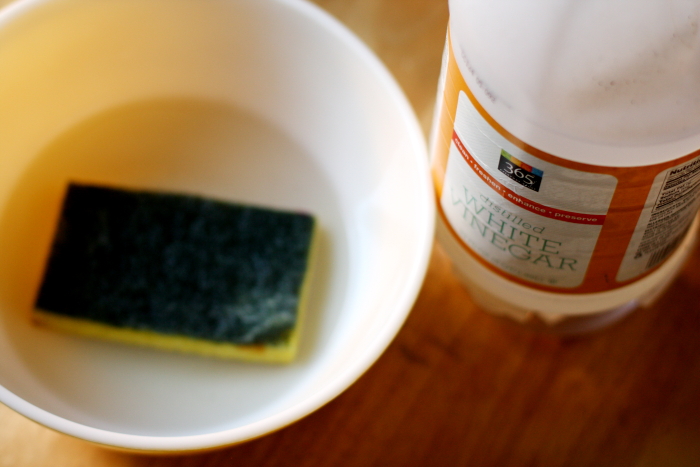
Recipe for Cleaning your Sponges
What you’ll need: bleach or vinegar
Washing Machine Method:
Place the sponges in the washing machine using a little bleach on the hottest cycle.
Microwave Method:
Microwave a damp sponge for thirty-second increments until it gets hot and steamy. Make sure the sponge doesn’t dry out or it may catch fire. Use tongs to remove sponge from microwave–itGreen Method
Soak your sponges in a small bowl filled with white vinegar overnight. Squeeze them out in the morning. Dump the vinegar down the sink–it will help kill bacteria there, too! Rinse the sponge.
Bonus: Acetic acid in the vinegar kills the bacteria and eliminates odors. This method extends the life of your sponge, doesn’t use harsh chemicals, and is safer than the microwave method.

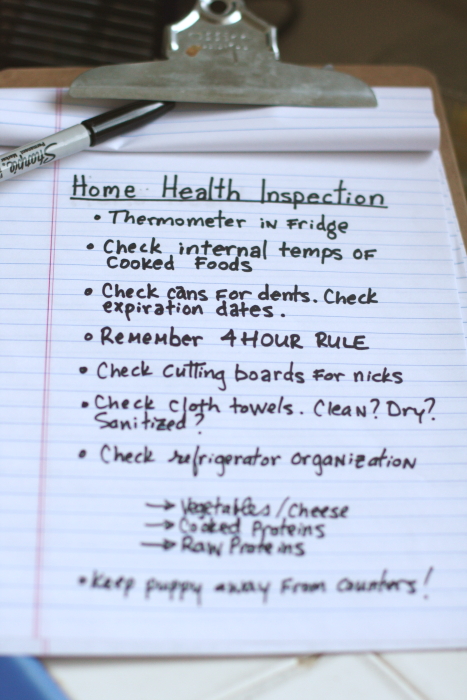
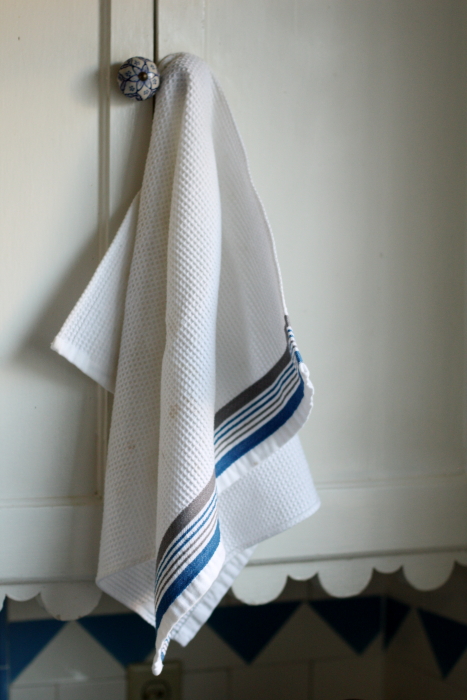
All terrific tips, Brooke – thanks! I went through a big overhaul of kitchen cleanliness habits a few years ago – like they say, when you know better you do better. Glad to know the 4 hour rule, I was just wondering about that earlier this week after I realized some meat had been sitting out a while (I tossed it to be safe).
Kathy, thank you for your kind words. I totally agree with what you say: “when you know better, you do better”! Absolutely. I shudder to think about how little I knew (and how unsafe I was) about food safety. Thank goodness for the internet and online food safety classes. We have access to much better tools now!
I love this article. Thank you for all the helpful reminders. You mentioned proper cooling techniques. If I make a brisket or chili and want to refrigerate it over night and re-heat it and serve it the next day, then what is the proper way to cool it before putting it in the refrigerator? Also, re: the 4 hour rule, what if I make hot food, and it sits out for 1 to 2 hours on the dinner table, is it then OK to refrigerate the leftovers for another day? Thanks again for a great post, Dana
Dana,
thanks for coming by! Proper cooling pretty much requires mindfulness. If you make brisket or chili you should let the food cool to room temperature before putting it in the refrigerator (putting it in hot will raise the temp inside your refrigerator and may compromise other foods). Health department requires you cool the food from 135 F to 70F within 2 hours and then from 70F to 41F within 4 hours–with a total cooling time of 6 hours. Frozen foods should be thawed under cool running water, in a microwave oven or as part of the cooking process. Never thaw food at room temperature. When reheating food always bring the temperature to at least 165F. Food can only be reheated once to 165F and old and new food should not be mixed.
Hope this helps!
Thanks for the reply. I am already implementing your tips. Best, Dana
Brooke, thank you so much for this! I’m sending this to my roommates who, delightful people though they may be, have long scoffed at my side of the fridge, with it’s labels and temperature zones and unspoiled milk. They say I’m being fussy, I say I’m avoiding the plague. It’s hard to laugh when you’re fighting a fresh case of botulism. 🙂
It’s also good to have the basics of food safety presented in an accessible way. All of the steps you laid out could be done in a tiny dorm room or a cavernous mansion, which is wonderful, as we all know that these things are seldom learned in youth. It’s silly when you think about it, because what kid wouldn’t have fun putting stickers in the cupboard and poking food with a thermometer?